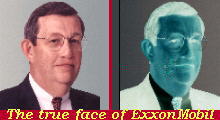|
|
|

 A new management structure
A new management structure|
With the merger in December 1999 ExxonMobil(*) announced to the press the implementation of a new management structure called "functional" organization. A cornerstone of our society is that each of us is responsible for his/her acts. To apply this concept not to individuals, but to companies, all countries have developed legislation in order to identify those who are individually responsible for the company potential wrongdoings. All over the world this responsibilty is assigned to the members of the board and the top managers in the assumption that they take the decisions: in this way the community is protected from improper behaviours. In line with this key concept Exxon Corporation had a proper decentralized management structure, so that the managers of the subsidiaries had wide authorities to act in the best interest of their own company in the framework of generic policies and strategies recommended by the Corporation. This multi-national structure allowed for a decision taking process very close to the business and thus responsive to market's need. This structure was also in full compliance with the spirit of the Law, respectful of the differences among the various countries and capable to develop a multi-national culture. 
Without being specific to any actual organization it can be said that the process called global functionalization assumes the the world ("the globe") is just one country and defines a management structure based on this assumption. The two generic structures (multi-national versus functional) can be summarized in this chart (**):
In my understanding in a global functional structure, decisions are taken by a bureaucracy remote from the local marketplace, with no personal exposure or responsibility towards the local community. The main staff organizations who usually support management in their decisions are centralized and they support functional management. Employees on the field are expected to ensure the flawless execution of whatever decision is taken by the remote functional management and directly communicated to them. Legal aspects are taken care of by writing everywhere that the so called corporate separateness between the Corporation and the subsidiaries is complied with and that the central bureaucracy is only advising. This paperwork, if properly done, may preserve a functional structure from being challenged by fiscal authorities. The sheer size of this advisory activity, however, may be such that it makes clear that the subsidiary's "official management" have just a notarial role. It is known that one of the reasons behind the collapse of the former Soviet Union was identified in the lack of a proper decentralization process. The Union was made by 15 republics, but all decisions were taken in Moskow. Without being abusive towards the supporters of the global functional model, nor towards the supporters of the former Soviet Union economic model, I find the two approaches very similar. Other pages about ExxonMobil: Introduction Cleopatra's nose and Lee's lips legal structure compliance with company policies. (*) The words ExxonMobil, Exxon and Mobil are used in a generic sense. I actually worked since January 1, 1966 for Esso Standard Italiana Spa, subsequently renamed Esso Italiana Spa and Esso Italiana Srl. On April 5, 2001 I was notified that my contract had been sold on January 1, 2001 to another company named ExxonMobil Mediterranea Srl (previously a subsidiary of Mobil). Four days after this notification I left the company. Therefore I never had any direct legally binding agreement with Exxon Corporation or ExxonMobil Corporation. (**) This chart is my own attempt to represent the main differences between two theoretical management structures in a generic company. 
This site is maintained by Roberto Piperno. Write to romapip@quipo.it |